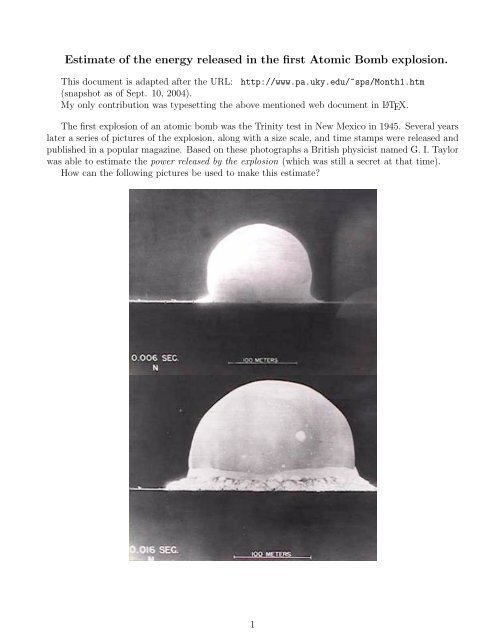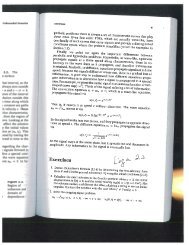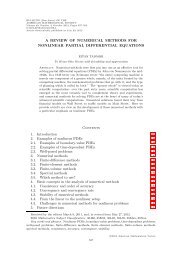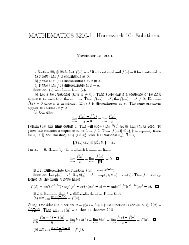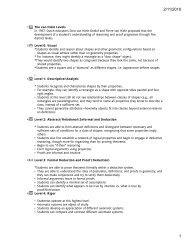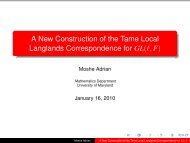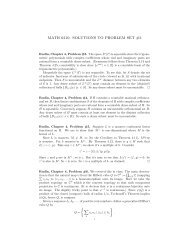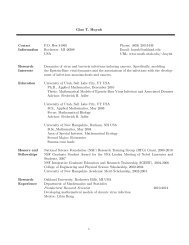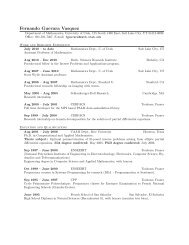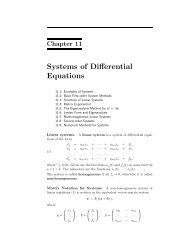Estimate of the energy released in the first Atomic Bomb explosion.
Estimate of the energy released in the first Atomic Bomb explosion.
Estimate of the energy released in the first Atomic Bomb explosion.
You also want an ePaper? Increase the reach of your titles
YUMPU automatically turns print PDFs into web optimized ePapers that Google loves.
<strong>Estimate</strong> <strong>of</strong> <strong>the</strong> <strong>energy</strong> <strong>released</strong> <strong>in</strong> <strong>the</strong> <strong>first</strong> <strong>Atomic</strong> <strong>Bomb</strong> <strong>explosion</strong>.<br />
This document is adapted after <strong>the</strong> URL: http://www.pa.uky.edu/~sps/Month1.htm<br />
(snapshot as <strong>of</strong> Sept. 10, 2004).<br />
My only contribution was typesett<strong>in</strong>g <strong>the</strong> above mentioned web document <strong>in</strong> L ATEX.<br />
The <strong>first</strong> <strong>explosion</strong> <strong>of</strong> an atomic bomb was <strong>the</strong> Tr<strong>in</strong>ity test <strong>in</strong> New Mexico <strong>in</strong> 1945. Several years<br />
later a series <strong>of</strong> pictures <strong>of</strong> <strong>the</strong> <strong>explosion</strong>, along with a size scale, and time stamps were <strong>released</strong> and<br />
published <strong>in</strong> a popular magaz<strong>in</strong>e. Based on <strong>the</strong>se photographs a British physicist named G. I. Taylor<br />
was able to estimate <strong>the</strong> power <strong>released</strong> by <strong>the</strong> <strong>explosion</strong> (which was still a secret at that time).<br />
How can <strong>the</strong> follow<strong>in</strong>g pictures be used to make this estimate?<br />
1
First two assumptions need to be made:<br />
1. The <strong>energy</strong> (E) was <strong>released</strong> <strong>in</strong> a small space.<br />
2. The shock wave was spherical.<br />
We have <strong>the</strong> size <strong>of</strong> <strong>the</strong> fire ball (R as a function <strong>of</strong> t) at several different times. How does <strong>the</strong> radius<br />
(R) depend on:<br />
• <strong>energy</strong> (E)<br />
• time (t)<br />
• density <strong>of</strong> <strong>the</strong> surround<strong>in</strong>g medium (ρ – <strong>in</strong>itial density <strong>of</strong> air)<br />
Let’s perform a dimensional analysis <strong>of</strong> <strong>the</strong> problem:<br />
2
• [R] = L :radius is determ<strong>in</strong>ed by a distance<br />
• [E] = ML 2 /T 2 :<strong>energy</strong> is determ<strong>in</strong>ed by a mass times a distance squared divided by time<br />
squared.<br />
• [t] = T :Time is determ<strong>in</strong>ed by <strong>the</strong> time.<br />
• [ρ] = M/L 3 :density is determ<strong>in</strong>ed by a mass divided by a distance cubed.<br />
We can say<br />
[R] = L = [E] x [ρ] y [t] z<br />
Substitut<strong>in</strong>g <strong>the</strong> units for <strong>energy</strong>, time and density that we listed above we have:<br />
[R] = L = M (x+y) L (2x−3y) T (−2x+z)<br />
M is to <strong>the</strong> x + y power because <strong>energy</strong> and density are both dependent on M.<br />
L is to <strong>the</strong> 2x − 3y power because <strong>energy</strong> is dependent on <strong>the</strong> square <strong>of</strong> distance and density is<br />
dependent on one over <strong>the</strong> cube <strong>of</strong> distance.<br />
T is to <strong>the</strong> −2x + z power because <strong>energy</strong> is dependent on one over <strong>the</strong> square <strong>of</strong> time and time<br />
is dependent on time. This provides three simultaneous equations:<br />
yield<strong>in</strong>g <strong>the</strong> results:<br />
The radius <strong>of</strong> <strong>the</strong> shock wave is <strong>the</strong>refore:<br />
x + y = 0,<br />
2x − 3y = 1,<br />
−2x + z = 0,<br />
x = 1/5, y = −1/5, z = 2/5.<br />
R = E 1/5 ρ −1/5 t 2/5 ∗ constant<br />
Let’s assume <strong>the</strong> constant is approximately 1.<br />
Solv<strong>in</strong>g <strong>the</strong> equation for E we get:<br />
E = (R 5 ρ)/t 2 .<br />
At t = .006 seconds <strong>the</strong> radius <strong>of</strong> <strong>the</strong> shock wave was approximately 80 meters. The density <strong>of</strong> air is<br />
ρ = 1.2 kg/m 3 . Plugg<strong>in</strong>g <strong>the</strong>se values <strong>in</strong>to <strong>the</strong> <strong>energy</strong> equation gives:<br />
E = (80 5 ) × 1.2/(.0062) kg ∗ m 2 /s 2<br />
= 1 × 10 14 kg ∗ m 2 /s 2<br />
= 1 × 10 21 ergs<br />
Now, 1 g <strong>of</strong> TNT = 4 × 10 10 erg, and hence<br />
E = 25 kilo − tons <strong>of</strong> TNT<br />
We would like to thank Pr<strong>of</strong>. Wolfgang Korsch for present<strong>in</strong>g this problem and its solution.<br />
3


